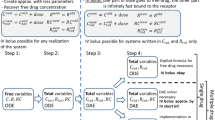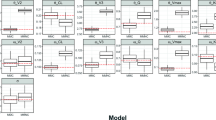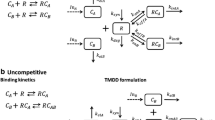Abstract
The Michaelis–Menten (M–M) approximation of the target-mediated drug disposition (TMDD) pharmacokinetic (PK) model was derived based on the rapid binding (RB) or quasi steady-state (QSS) assumptions that implied that the target and drug binding and dissociation were in equilibrium. However, the initial dose for an IV bolus injection for the M–M model did not account for a fraction bound to the target. We postulated a correction to an initial condition that was consistent with the assumptions underlying the M–M approximation. We determined that the difference between the injected dose and one that should be used for the initial condition is equal to the amount of drug bound to the target upon reaching the equilibrium. We also observed that the corrected initial condition made the internalization rate constant an identifiable parameter that was not for the original M–M model. Finally, we performed a simulation exercise to check if the correction will impact the model performance and the bias of the M–M parameter estimates. We used literature data to simulate plasma drug concentrations described by the RB/QSS TMDD model. The simulated data were refitted by both models. All the parameters estimated from the original M–M model were substantially biased. On the other hand, the corrected M–M is able to accurately estimate these parameters except for equilibrium constant Km. Weighted sum of square residual and Akaike information criterion suggested a better performance of the corrected M–M model compared with the original M–M model. Further studies are necessary to determine the importance of this correction for the M–M model applications to analysis of TMDD driven PK data.



Similar content being viewed by others
References
Mager DE, Jusko WJ (2001) General pharmacokinetic model for drugs exhibiting target-mediated drug disposition. J Pharmacokinet Pharmacodyn 28:507–532
Mager DE, Krzyzanski W (2005) Quasi-equilibrium pharmacokinetic model for drugs exhibiting target-mediated drug disposition. Pharm Res 22:1589–1596
Gibiansky L, Gibiansky E, Kakkar T, Ma P (2008) Approximations of the target-mediated drug disposition model and identifiability of model parameters. J Pharmacokinet Pharmacodyn 35:573–591
Yan X, Mager DE, Krzyzanski W (2010) Selection between Michaelis–Menten and target-mediated drug disposition pharmacokinetic models. J Pharmacokinet Pharmacodyn 37:25–47
Wang Y-MC, Krzyzanski W, Doshi S, Xiao JJ, Perez-Ruixo JJ, Chow AT (2010) Pharmacodynamics-mediated drug disposition (PDMDD) and precursor lifespan model for single dose of romiplostim in healthy subjects. AAPS J 12:729–740
Acknowledgment
This work was supported by the National Institutes of Health Grant GM 57980.
Author information
Authors and Affiliations
Corresponding author
Appendices
Appendices
Appendix A: Equations describing the RB/QSS TMDD PK model
The following equations were proposed as RB and QSS approximations of the TMMD PK model and adopted for the IV bolus drug administration [2, 3]:
Here k syn denotes the zero-order rate constant for production of the target, and k deg is the first-order rate constant for the degradation of the target.
Appendix B: Derivation of Eq. 6
The free drug plasma concentration described by (4) is a solution to the equilibrium equation [2, 3]:
where K eq = K D (RB) and K eq = K SS (QSS). Upon multiplying both sides of (14) by C tot – C and rearranging the terms of the equation one can arrive at
Dividing both sides of (15) by K eq + C yields
For the RB/QSS TMDD model at time 0, C tot (0) = Dose/V and R(0) = R tot0. Therefore the correct initial condition for the M–M approximation C(0) = C corr (0) satisfies the following relationship:
which proves Eq. 6.
Rights and permissions
About this article
Cite this article
Yan, X., Krzyzanski, W. Dose correction for the Michaelis–Menten approximation of the target-mediated drug disposition model. J Pharmacokinet Pharmacodyn 39, 141–146 (2012). https://doi.org/10.1007/s10928-011-9233-1
Received:
Accepted:
Published:
Issue Date:
DOI: https://doi.org/10.1007/s10928-011-9233-1




